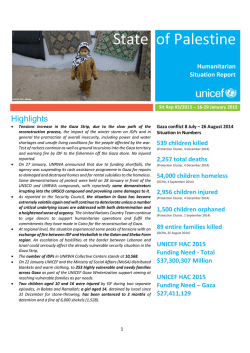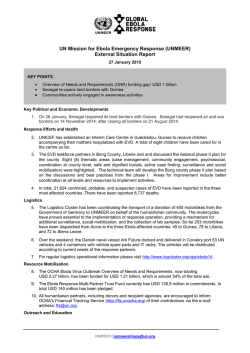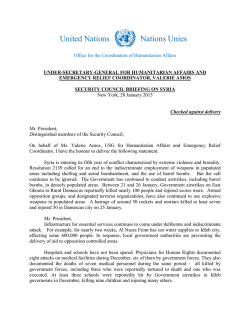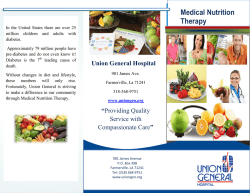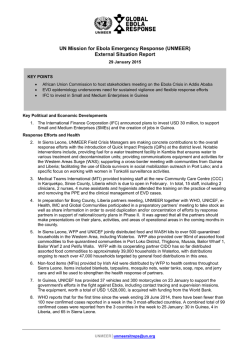
Download PDF (480.95 KB)
2015 ©UNICEF/Eritrea/2014/Pirozzi Humanitarian Action for Children Total affected population: 1,200,000 Eritrea Total affected children (under 18): 696,000 Eritrea is situated in the drought-prone region of the Horn of Africa, rendering it vulnerable to persistent water shortages and food deficits. In good years, approximately half of total food needs are met by domestic production; in bad years, about one quarter. The economic condition has been dominated by a resource-sapping “no war no peace” situation with Ethiopia and a soaring cost of food staples that Eritrea needs to import – especially cereals, which have more than doubled in price over the past four years. The robust rainy season of 2014 may significantly improve the food security situation of the highland areas but not that of the coastal lowland regions. The current production shortfalls were highlighted by the government in January 2014, indicating predicted 2013 harvest levels could not be met due to poor rainfall performance that year. The household food and livelihood security may escalate already high malnutrition rates among children under 5 years of age and pregnant and lactating women. In the absence of updated nutrition data for 2014, the trends analysis from the Nutrition Sentinel Site Surveillance system (NSSS), have indicated fluctuating trends of malnutrition in the past three years. Figures from the NSSS in December 2013 compared to December 2012 showed an increasing trend in acute malnutrition in four out of six regions, including Anseba, Gash-Barka, Maekel and Southern Red Sea (SRS)1. The impact of landmines and explosive remnants of war (ERW) in 2014 continued to have serious impact, including causing child death, injuries and disabilities in war-affected communities, as the humanitarian mine action programmes in the country have increasingly weakened. Only 25 per cent of the minefields have been cleared. The injury burden has increased from 58,111 cases in 2011 to 63,356 in 2012; the majority of the injuries and fatalities were among children and young people. According to Health Management Information System (HMIS) report, in 2013, injury cases (58,232) showed a reduction of 8.08 per cent in comparison to 2012. The access to improved sanitation facilities in rural areas is estimated at 16.3 per cent2, with huge regional disparities. Coupled with this, and according to the EPHS 2010, access to improved drinking water within rural areas is at 50 per cent. Operation and maintenance of established systems remains a significant challenge. Humanitarian strategy Humanitarian response has been merged into development programming with the priority interventions targeting the most vulnerable population groups and geographical areas. Under the overall Strategic Partnerships Cooperation Framework (SPCF) with the Government of Eritrea, sectoral coordination mechanisms are in place where UNICEF is playing an active role in relevant thematic outcome areas including WASH, Health, Nutrition and Protection, and coordinating efforts with the Ministry of National Development and line ministries. UNICEF, in collaboration with the Ministry of Health (MoH), is responding to the situation of malnutrition through supporting facilitybased as well as community-based 1 2 therapeutic and supplementary feeding, targeting severely and moderately malnourished under-five children. In the absence of WFP in-country, UNICEF is also supporting a phased implementation of a blanket supplementary feeding programme at the national scale to prevent further deterioration of the nutritional status of children under five years and pregnant and lactating mothers. UNICEF will continue implementing existing interventions in 2015. To avert child mortality from all causes, UNICEF is providing Vitamin-A supplementation twice yearly to all children 6-59 months. UNICEF ensured convergence of programmes to the extent possible in order to maximize their complementary impacts on vulnerable populations. For National Nutrition Sentinel Site Surveillance Systems, 2013 The Latrine Coverage Survey, 2011 Total people to be reached in 2015: 462,000 Total children to be reached in 2015: 350,000 2015 Programme Targets Nutrition 14,000 children aged 6-59 months receive treatment for severe acute malnutrition (SAM) 350,000 children in humanitarian situations aged 6-59 months receive vitamin-A supplementation Health 110,000 children immunized against vaccine-preventable diseases 30,000 children under five with improved access to community integrated management of new-born and childhood illnesses WASH 56,000 people in humanitarian situations access water for drinking, cooking and personal hygiene 56,000 people in humanitarian situations receive information on appropriate hygiene practices Child Protection 250,000 children and young people provided with integrated mine risk education program 8,000 child victims of landmine/ERW, children of landmine survivors and children living with disabilities receive support Education 25,000 nomadic children accessing formal / non-formal education 5,000 children in humanitarian situations access formal / nonformal education www.unicef.org/appeals/eritrea instance, UNICEF focuses its Mine Risk Education (MRE) programme on the landmine- and ERW-impacted regions, while WASH and Nutrition programmes focus on drought-prone rural communities that also have a high prevalence of food insecurity and malnutrition. UNICEF will continue to provide improved access to sustainable, safe water supplies and institutional sanitation facilities (schools and health centres), building resilience in droughtaffected communities. In addition, emergency WASH efforts including the provision of clean water will be coupled with the dissemination of hygiene promotion messages with the aim of improving the impact of humanitarian programmes in drought-affected areas. Results from 2014 In 2014, UNICEF appealed for US$15,800,000, however as of midNovember only US$753,899 was available against this requirement. Lack of funding was a critical challenge for the Country Office and in order to enable the response to pressing humanitarian needs, UNICEF had to draw on non-emergency resources, mainly US$4 million that supported the treatment of 13,000 children under-5 with acute malnutrition. The geographic focus of WASH interventions in 2014 has been the drought-prone remote regions, and two environmentally sustainable water supply projects using solar powered pumping technology were constructed in the southern regions in Adi Unday and Unda Beylul communities. Hygiene promotion activities have reached an estimated 9,200 people with an additional 1,500 people being reached in Unda Beylul as part of the ongoing WASH activities in the community. In Basic Education, with funding from the regular programme, UNICEF provided resources to the Ministry of Education to equip 90 nomadic schools with furniture to benefit at least 12,000 children (45 per cent girls). UNICEF has also funded the training of 100 teachers for newly opened nomadic schools and continuous community mobilisation, which resulted in an increase in enrolment of new students into Nomadic Education centres from 5,726 in 2013 to 11,934 in 2014, bringing the total number of nomadic children accessing education to 23,934. In Health and Nutrition, with UNICEF support, in the first half of the year, over 354,820 children 6-59 months of age benefitted from Vitamin-A supplementation and were also screened for malnutrition with MUAC during Child Health and Nutrition Week (CHNW) 1st round in June 2014. Out of the screened children, 18,390 malnourished children were identified and referred to nearby health facilities for further screening and management of malnutrition. In addition some 290 health workers and 975 community volunteers were trained on Integrated Management of Acute Malnutrition and Infant and Young Child Feeding (IMAM/IYCF) in all 532 intervention sites. Also, 8,000 severely malnourished and 30,000 moderately malnourished children under 5 were treated. UNICEF has also assisted MoH by providing vaccines and injectable supplies for the year. Additional outreach services for routine immunization and for capacity building on EPI and four Rounds of Integrated Outreach services using the Reach Every District (RED) strategy to impact the hard-to-reach children was implemented in 18 districts. Through the school-based Mine Risk Education programmes, 305 school teachers were trained on MRE and 165 landmine- and ERW-impacted schools were covered. Through these MRE activities, over 165,000 school children were reached with awareness and education on the threat posed by mines and ERW in the highly war-affected communities in Gash Baraka and Northern Red Sea. The community-based MRE activities also reached around 300,000 children out of school in the landmine- and ERWimpacted communities in the six districts. 2014 PROGRAMME TARGETS AND RESULTS NUTRITION Children < 5 years old with severe acute malnutrition admitted into therapeutic feeding programme Children < 5 years old receiving micronutrient supplementation HEALTH Children < 5 immunized against vaccine-preventable diseases Children <5 receive improved access to specialised neonatal services WATER, SANITATION AND HYGIENE Population provided with access to safe water as per agreed standards Population provided with access to basic sanitation facilities and practise hygiene CHILD PROTECTION Children and young people in and out of school provided with an integrated mine risk education programme on injury prevention in high risk communities 3 4 Data on measles as of end September, 2014 Data for 2014 not yet released by Ministry of Health; activities are still ongoing UNICEF 2014 Target UNICEF Total Results 14,000 8,000 490,000 354,820 130,000 151,000 99,3933 10,000 20,000 3,500 9,200 300,000 165,000 4 www.unicef.org/appeals/eritrea EDUCATION Nomadic children given equitable access to quality education Children in humanitarian situations accessing formal/non-formal education 25,000 5,000 23,934 All data is as of end October 2014 unless indicated otherwise. Funding requirements In line with the country’s emergency situation and vulnerability, UNICEF is requesting US$13,500,000 to meet the humanitarian needs of children in Eritrea in 2015. Without additional funding UNICEF will be unable to support the national response to the country’s continuing nutrition crisis as well as provide critical WASH services to the population in need. Basic supplies for primary education are also urgently needed to uphold children’s right to education. Nutrition 5,500,000 Health 1,500,000 Water, Sanitation & Hygiene 2,500,000 Child Protection 2,500,000 Education 1,500,000 Total For further information please contact: Suleiman Braimoh Representative, UNICEF Eritrea Country Office Tel: + 291 1 186222 Email: [email protected] 2015 Requirements (US$) Sector Yasmin Haque Deputy Director, Office of Emergency Programmes (EMOPS) UNICEF, New York Tel: +1 212 326 7150 Email: [email protected] 13,500,000 Olav Kjørven Director, Public Partnerships Division (PPD) UNICEF, New York Tel: +1 212 326 7160 Email: [email protected]
© Copyright 2024
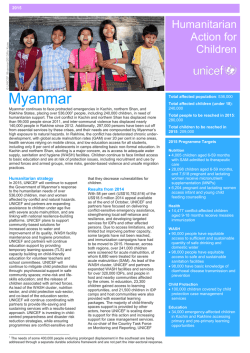
![Current appeal [PDF]](http://s2.esdocs.com/store/data/000476858_1-ff5bfc045afda14d4551c905d8c862b7-250x500.png)
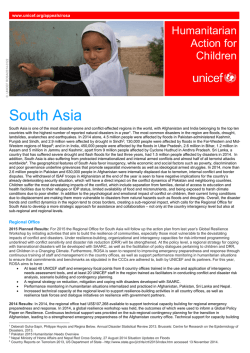
![Current appeal [PDF]](http://s2.esdocs.com/store/data/000470301_1-1a2ac0338c7b87d842a9839e11e746d1-250x500.png)
![Current appeal [PDF]](http://s2.esdocs.com/store/data/000456387_1-84443a4282546a8fcd8c29f2bdd10a65-250x500.png)
